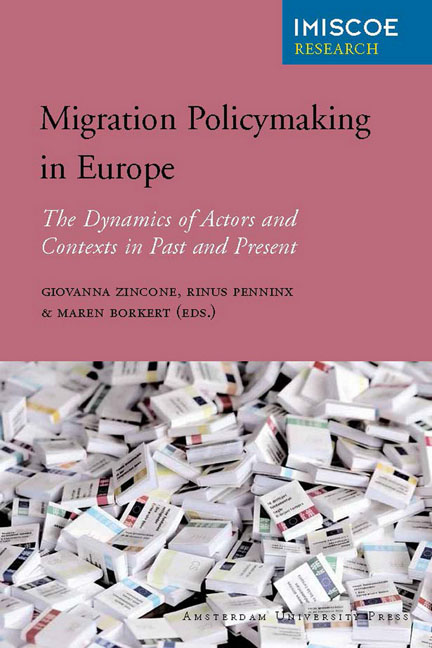Book contents
- Frontmatter
- Contents
- Policymaking in the Field of Migration and Integration in Europe: An Introduction
- Part I Post-War Migration Countries
- Part II Mediterranean Migration Countries
- Part III Eastern European Countries
- Conclusion: Comparing the Making of Migration Policies
- List of Contributors
- Other IMISCOE Titles
4 - The Case of the Netherlands
Published online by Cambridge University Press: 20 January 2021
- Frontmatter
- Contents
- Policymaking in the Field of Migration and Integration in Europe: An Introduction
- Part I Post-War Migration Countries
- Part II Mediterranean Migration Countries
- Part III Eastern European Countries
- Conclusion: Comparing the Making of Migration Policies
- List of Contributors
- Other IMISCOE Titles
Summary
Introduction
In the post-war period, the Netherlands regarded itself an ‘overpopulated’ country. Both public opinion and government documents explicitly stated that the Netherlands was not – and should not become – an immigration country (Ministerie van Sociale Zaken en Volksgezondheid 1970). To the contrary, emigration was openly encouraged through government policies and, between 1946 and 1972, more than half a million Dutch citizens emigrated to countries such as Canada, Australia and New Zealand. Nevertheless, during that same period, the Netherlands did in fact become an immigration country. Migration statistics show that from the beginning of the 1960s, with the sole exception of the depression of 1967, the country's net migration balance was consistently positive until 2004, with immigrants arriving in different periods and for various reasons.
This chapter begins with an overview of migration waves to the Netherlands, provided more or less in chronological order. Following the introduction, the second section describes the evolution of Dutch immigration and integration policies over the years. The third section reconstructs the processes of immigration policymaking, while the fourth section deals with integration policymaking. The analysis considers the different processes, actors, levels and governance patterns that have influenced policies in each of these domains. The chapter's fifth section compares the dynamics of the immigration and integration fields, evaluating their interaction and, in so doing, identifying two types of factors that shape their dynamics. While the fourth section focuses on the internal mechanisms of migration and integration, the sixth section emphasises the role of various external factors such as the welfare state policies, the political framework and the political climate. Finally, the chapter concludes with a summary of the Dutch case's most salient characteristics.
The first migrants to arrive to the Netherlands were so-called repatriates who came from the Dutch East Indies, or what today are Indonesia and New Guinea. Their arrival was a consequence of the decolonisation process taking place in the former Dutch colonies. In total, this population was estimated to comprise approximately 300,000 individuals in the years spanning 1946 to 1962. Most repatriates were of mixed Indonesian-Dutch descent, being entitled to settle in the Netherlands on the grounds of their Dutch citizenship.
- Type
- Chapter
- Information
- Migration Policymaking in EuropeThe Dynamics of Actors and Contexts in Past and Present, pp. 129 - 164Publisher: Amsterdam University PressPrint publication year: 2012



